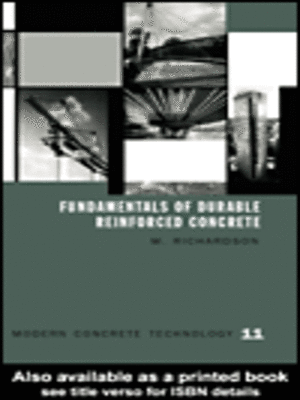Fundamentals of Durable Reinforced Concrete
ebook ∣ Modern Concrete Technology Series
By Mark G. Richardson

Sign up to save your library
With an OverDrive account, you can save your favorite libraries for at-a-glance information about availability. Find out more about OverDrive accounts.
Find this title in Libby, the library reading app by OverDrive.



Search for a digital library with this title
Title found at these libraries:
| Library Name | Distance |
|---|---|
| Loading... |
Durability failures in reinforced concrete structures are wasteful of resources and energy. The introduction to practice of European Standard EN 206-1 represents a significant shift in emphasis on the need to explicitly consider each potential durability threat when specifying and producing concrete.
Fundamentals of Durable Reinforced Concrete presents the fundamental aspects of concrete durability including reinforcement corrosion, carbonation, chloride ingress, alkali-aggregate reaction, freeze/thaw damage, sulphate attack, chemical attack, cracking, abrasion and weathering. The background to the durability exposure classes in EN 206-1 is also explained. Future directions in performance-based specifications and mathematical modelling of degradation are presented.
This book will be of particular interest to specifiers applying the principles of the new European Standard EN 206-1 for the first time, to postgraduate researchers in mathematical modelling of degradation mechanisms, to undergraduates of engineering, architecture and building technology, and students of advanced concrete technology who require a concise source of reference on concrete durability.
Fundamentals of Durable Reinforced Concrete presents the fundamental aspects of concrete durability including reinforcement corrosion, carbonation, chloride ingress, alkali-aggregate reaction, freeze/thaw damage, sulphate attack, chemical attack, cracking, abrasion and weathering. The background to the durability exposure classes in EN 206-1 is also explained. Future directions in performance-based specifications and mathematical modelling of degradation are presented.
This book will be of particular interest to specifiers applying the principles of the new European Standard EN 206-1 for the first time, to postgraduate researchers in mathematical modelling of degradation mechanisms, to undergraduates of engineering, architecture and building technology, and students of advanced concrete technology who require a concise source of reference on concrete durability.







